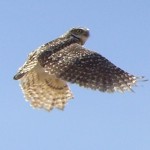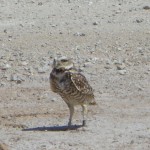With a decrease in fossorial (burrowing) animals, burrowing owls are finding fewer places to nest. This week we joined a group that has been working with Wild at Heart, inc., (burrowing owl relocation) to create artificial nesting sites for burrowing owls at Cibola National Wildlife Refuge (NWR) a couple hours north of Imperial NWR in Arizona.
Although we don’t consider ourselves birders, we do enjoy learning about birds and working with those who have extensive experience with them. Several weeks ago, a group of volunteers and staff from the refuge complex dug burrows, placed buckets below ground and pipes leading to them, and covered the sites with dirt. They erected large tents to cover the sites and contain the burrowing owls that they released within the tents. Then they left the animals to accustom themselves to their new homes, hoping several would nest.
Uncover the Sites
 Our job this day was to remove the tents and allow the owls to either fly off seeking new burrows which had been created for them nearby or to remain to protect the eggs they’d laid in the tented burrows. The windy day added an extra challenge as the tents reacted as a sail on a boat, tugging and billowing as we dragged them to the ground to fold them.
Our job this day was to remove the tents and allow the owls to either fly off seeking new burrows which had been created for them nearby or to remain to protect the eggs they’d laid in the tented burrows. The windy day added an extra challenge as the tents reacted as a sail on a boat, tugging and billowing as we dragged them to the ground to fold them.
Once uncovered, several of the owls flew off. But others remained, stunned by the activity and irritated by the disturbance. Those that remained had established nests, determined by a camera snaked into the tunnels toward the underground buckets where parent owls guarded their eggs.
Rattlesnake Country

As we removed tent supports and stakes, I was alarmed by the sound of a rattlesnake – a vibration that I’d often heard when Chuck and I search for snakes in the desert. I froze in place. “I hear a rattler,” I announced.
“That’s just one of the owls,” someone with more bird experience told me. “You can see him at the entrance to this burrow.” I peered into one of the pipes extending from the ground and stared at an annoyed owl glaring back. “They make a hissing noise that sounds like a rattlesnake to scare away predators,” she explained. It was quite convincing!
New Opportunity
After working all day to uncover three of the man-made sites, our group disbanded and returned home, allowing the burrowing owls time to adjust to their new freedom. Time will tell if they remain in the area and continue to use the burrows that hard work created. For now, however, we all had the satisfaction of knowing that a new generation of owls had new opportunity.



